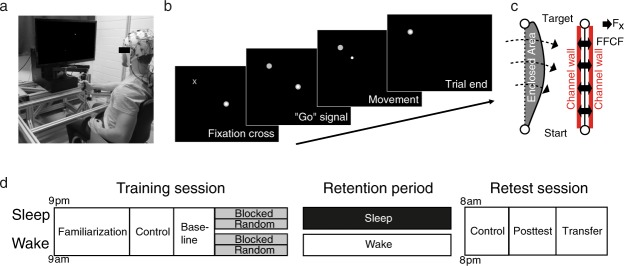Figure 1.
(a) The motor adaptation task was performed using a robotic manipulandum (Kinarm End-Point Lab, BKIN Technologies) with a custom made low-friction air-sled system. The robotic manipulandum could induce force fields to perturb participants’ hand movements. During the task, each participant’s EEG was recorded. (b) Example of one trial from the highlighting of the fixation cross until the trial ended by reaching the target. (c) Sketch of the parameters quantifying motor error (enclosed area, EA) and the adaptation coefficient (force-field compensation). Enclosed area (left) was defined by the area between the trajectory and the straight line between the start point and the target. Arrows indicate the force-field direction. The adaptation coefficient (right) was computed using the subject’s forces (Fx) directed against virtual channel walls and compared to the ideal force profile to cancel out the perturbation. (d) All participant groups had a Training session in which they performed the motor adaptation task with their dominant right hand, including a Familiarization phase, Control tests (subjective sleepiness, mood, and vigilance), Baseline, and the force-field Training (gray blocks). After a Retention period, Retest performance was quantified in a Posttest and an additional Transfer test with the left hand. Groups differed in their training and consolidation periods. The Random groups were trained on the motor adaptation task under highly variable force-field conditions and the Blocked groups were trained under more stable conditions. The Wake groups trained in the morning and were retested in the evening and the Sleep groups were trained in the evening and retested the following morning after a night of sleep.

